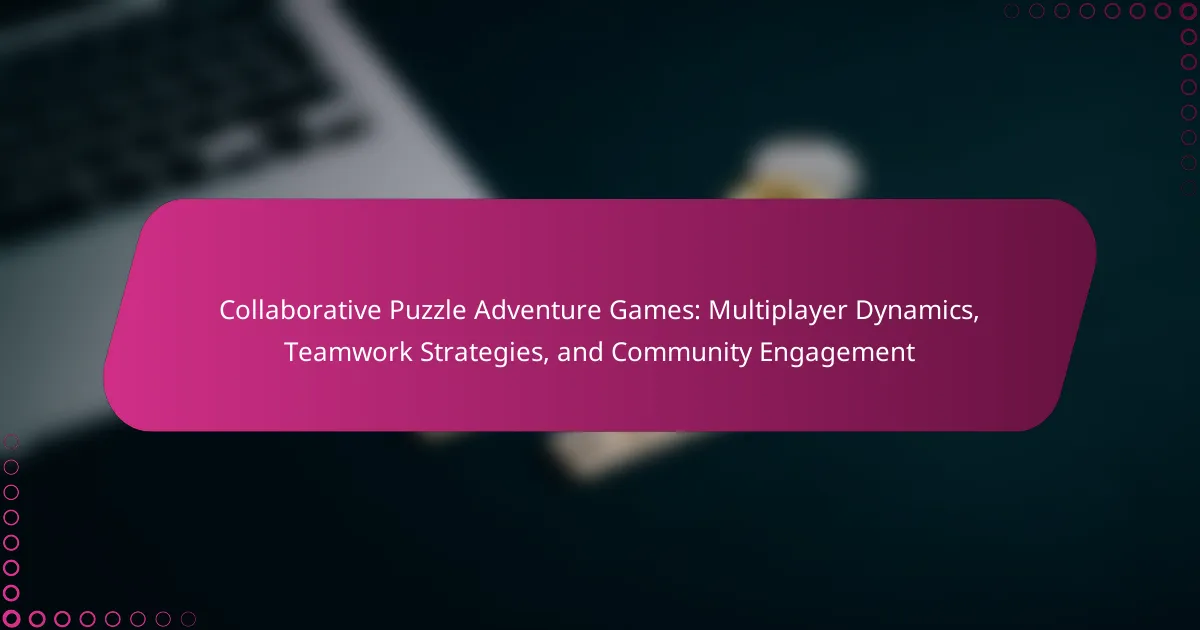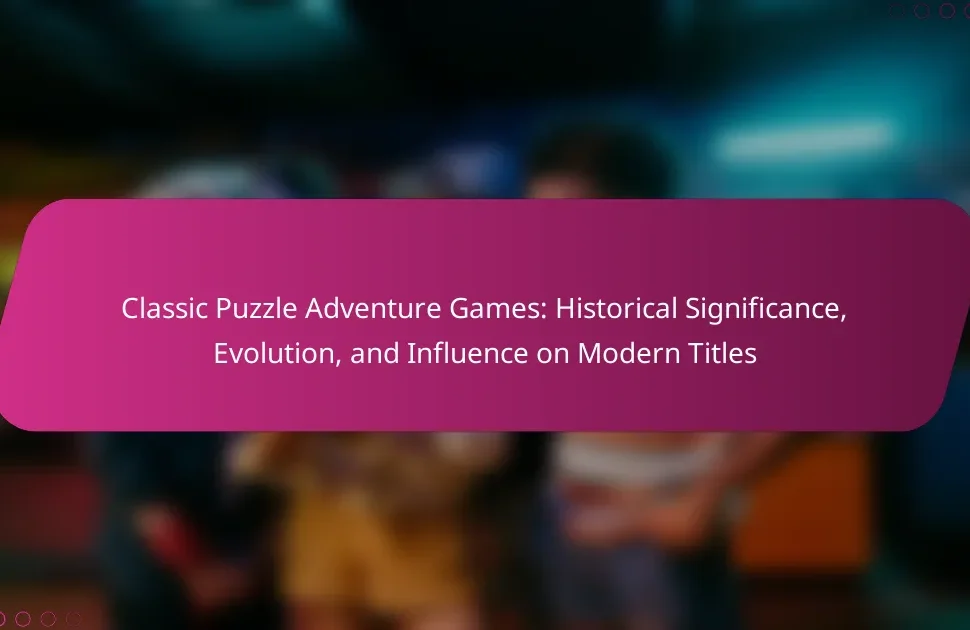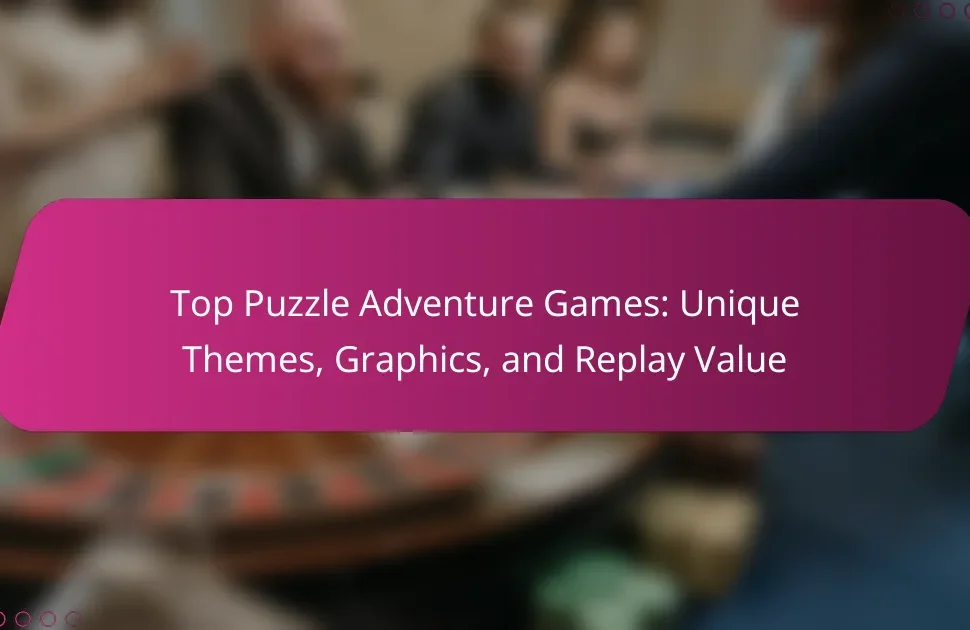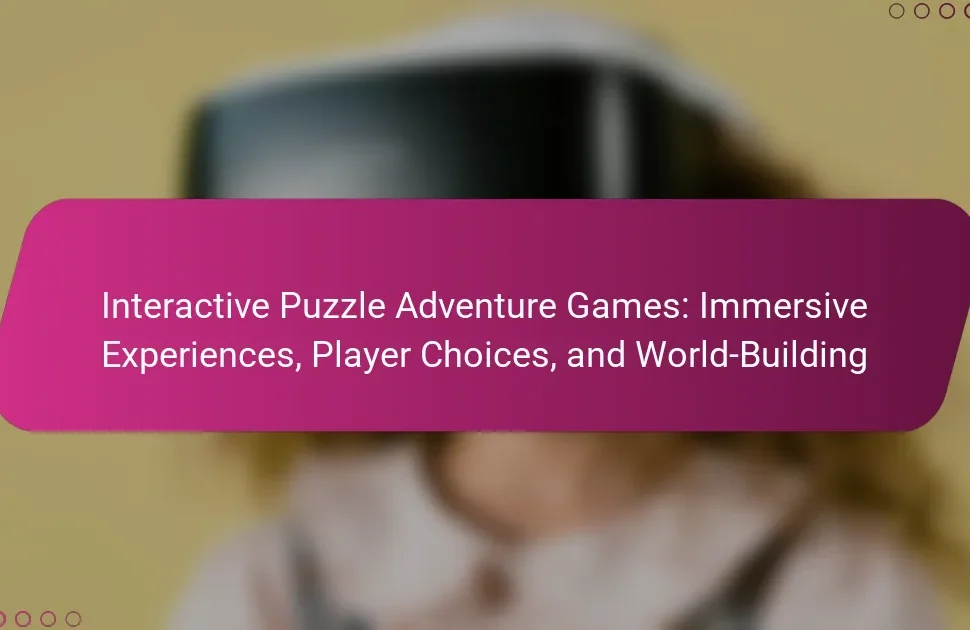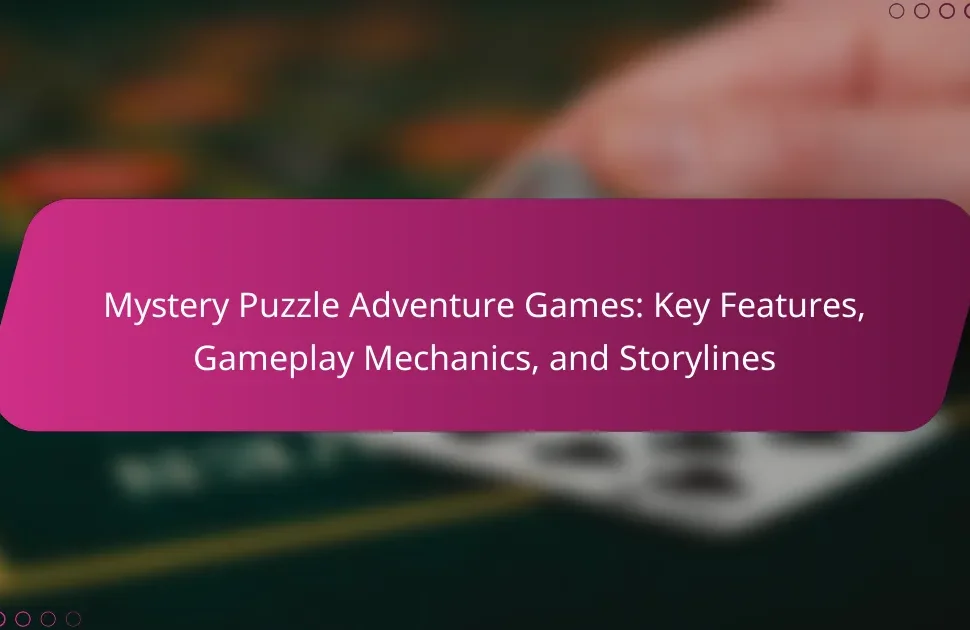Collaborative puzzle adventure games offer players the chance to enhance teamwork and problem-solving skills while engaging in immersive experiences. This article explores multiplayer dynamics, effective teamwork strategies, and the importance of community engagement. It also examines player roles, cultural influences, and emerging trends that shape collaborative gameplay, fostering a richer gaming experience.

What are the fundamental mechanics of collaborative puzzle adventure games?
Collaborative puzzle adventure games rely on teamwork, communication, and shared problem-solving to succeed. Players engage in various roles, leveraging unique skills to navigate challenges. Effective strategies include dividing tasks based on strengths, maintaining open dialogue, and building community through shared experiences. These dynamics enhance player engagement and foster a sense of accomplishment.
How do multiplayer dynamics shape player interactions?
Multiplayer dynamics significantly enhance player interactions by fostering teamwork and communication. Players collaborate to solve puzzles, leveraging diverse skills and strategies. This interaction promotes community engagement as players share experiences and form lasting connections. Successful teams often exhibit strong coordination, which can lead to improved gameplay outcomes.
What role does teamwork play in solving puzzles?
Teamwork is essential in solving puzzles as it enhances problem-solving efficiency and fosters creativity. Collaborative Puzzle Adventure Games leverage diverse skills, allowing players to tackle challenges from multiple perspectives. Effective communication among team members leads to better strategy formulation, ensuring that tasks are completed more quickly. Additionally, teamwork builds community engagement, creating a shared sense of accomplishment and enjoyment in the gaming experience. Through collaboration, players can combine their strengths, leading to innovative solutions that might not emerge in solo play.
Which game design elements enhance collaboration?
Collaborative puzzle adventure games enhance collaboration through shared objectives, communication mechanics, and problem-solving dynamics. These elements foster teamwork and community engagement.
Key game design elements include:
– **Shared Objectives**: Clear goals encourage players to work together towards common outcomes.
– **Communication Mechanics**: In-game chat or voice options facilitate real-time discussions, enhancing strategy development.
– **Cooperative Challenges**: Puzzles requiring multiple players to solve promote interdependence and teamwork.
– **Role Specialization**: Assigning unique roles to players allows them to contribute distinct skills, enhancing group dynamics.
– **Feedback Systems**: Real-time feedback on group performance encourages adaptive strategies and collective learning.
– **Community Features**: Social hubs or forums strengthen player connections and support collaborative play outside of gaming sessions.
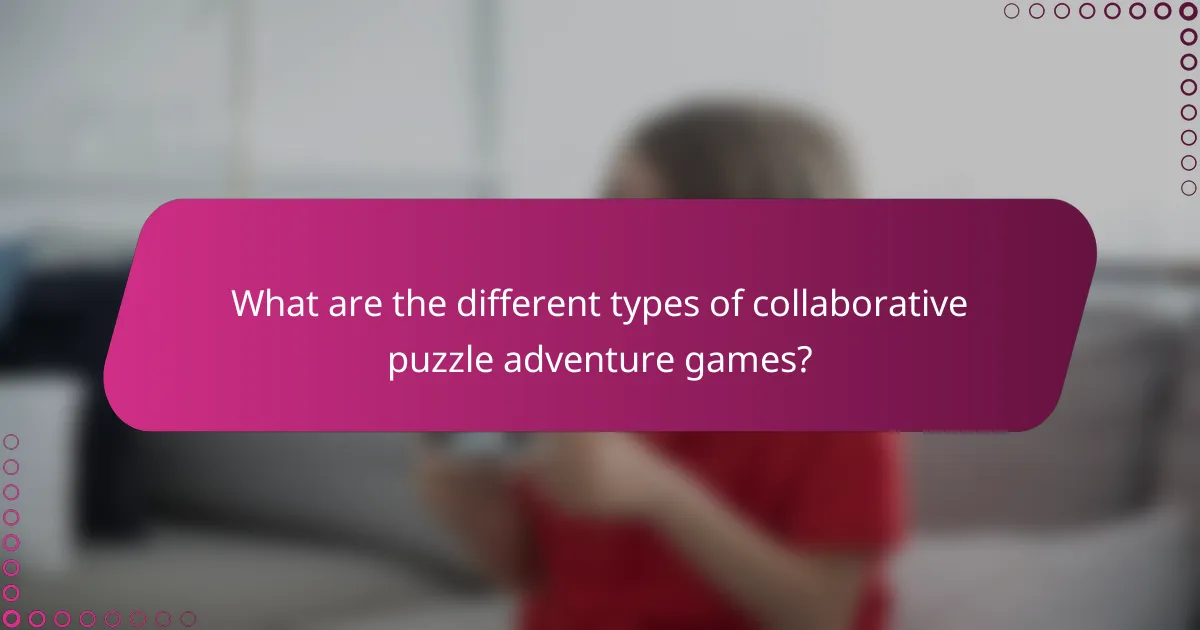
What are the different types of collaborative puzzle adventure games?
Collaborative puzzle adventure games typically fall into several types, each emphasizing teamwork and problem-solving. These include escape room games, where players solve puzzles to “escape” within a time limit; narrative-driven games that require players to work together to progress through a story; sandbox games that allow players to create and solve challenges collaboratively; and online multiplayer games that feature cooperative quests and missions. Each type fosters community engagement and enhances multiplayer dynamics through shared objectives and strategies.
How do narrative-driven games differ from mechanics-focused games?
Narrative-driven games focus on storytelling, while mechanics-focused games prioritize gameplay mechanics. Collaborative puzzle adventure games blend these elements, emphasizing teamwork and community engagement. Players often rely on narrative cues for problem-solving, enhancing social interaction. In contrast, mechanics-focused games may lack this depth, concentrating solely on skill and strategy. This difference impacts player experience and engagement levels.
What unique features do popular titles like “Portal 2” and “Keep Talking and Nobody Explodes” offer?
“Portal 2” and “Keep Talking and Nobody Explodes” offer unique features that enhance collaborative gameplay. “Portal 2” emphasizes spatial reasoning and communication through its innovative portal mechanics. Players must work together to solve complex puzzles, utilizing their distinct perspectives to navigate the environment effectively. In contrast, “Keep Talking and Nobody Explodes” requires real-time communication, as one player defuses a bomb while others provide instructions from a manual. This dynamic fosters teamwork and quick thinking under pressure, making both games exemplary in promoting multiplayer dynamics and community engagement.
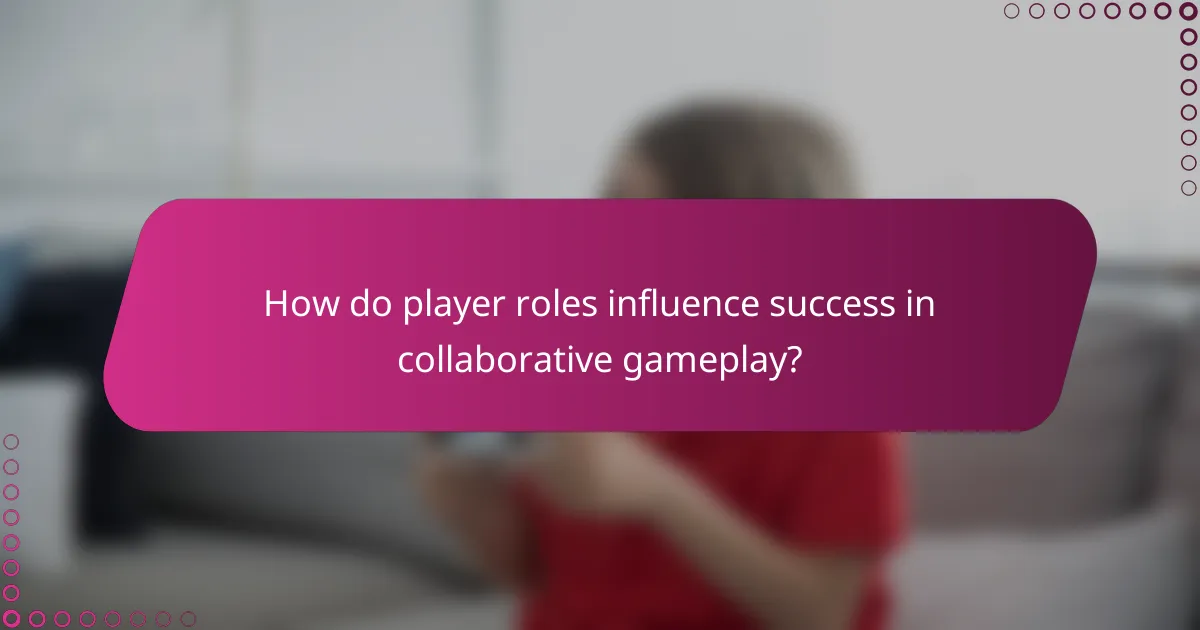
How do player roles influence success in collaborative gameplay?
Player roles significantly influence success in collaborative gameplay by enhancing teamwork and optimizing strategies. Each role contributes unique skills that can address specific challenges within the game. For instance, a strategist may excel in planning, while a communicator ensures effective coordination.
Understanding these dynamics allows teams to leverage individual strengths, improving overall performance. In collaborative puzzle adventure games, roles can be categorized into problem solvers, supporters, and leaders. Problem solvers tackle puzzles, supporters assist teammates, and leaders guide the group. This division of labor fosters efficiency and engagement, ultimately leading to a more rewarding gaming experience.
Effective role assignment is crucial. Teams that recognize and utilize player strengths tend to achieve higher success rates. Additionally, fostering an environment of open communication enhances collaboration, enabling players to adapt and respond to challenges dynamically.
In summary, player roles in collaborative gameplay create a structured approach to teamwork that maximizes each member’s contributions, leading to successful outcomes and enriched community engagement.
What are common roles players assume during gameplay?
Players in collaborative puzzle adventure games often assume roles such as problem-solver, communicator, strategist, and supporter. Each role enhances teamwork and contributes to gameplay success. Problem-solvers focus on finding solutions to puzzles. Communicators share vital information and coordinate efforts. Strategists plan approaches to challenges, while supporters assist others, ensuring a balanced team dynamic. These roles foster community engagement and enhance the overall gaming experience.
How can players effectively communicate their roles?
Players can effectively communicate their roles by establishing clear expectations and using designated in-game signals. Open dialogue fosters teamwork and enhances strategic planning. Regularly checking in with teammates ensures everyone is aligned on objectives. Utilizing voice chat or text communication tools can clarify strategies and immediate needs. This approach strengthens collaboration and improves overall game performance.
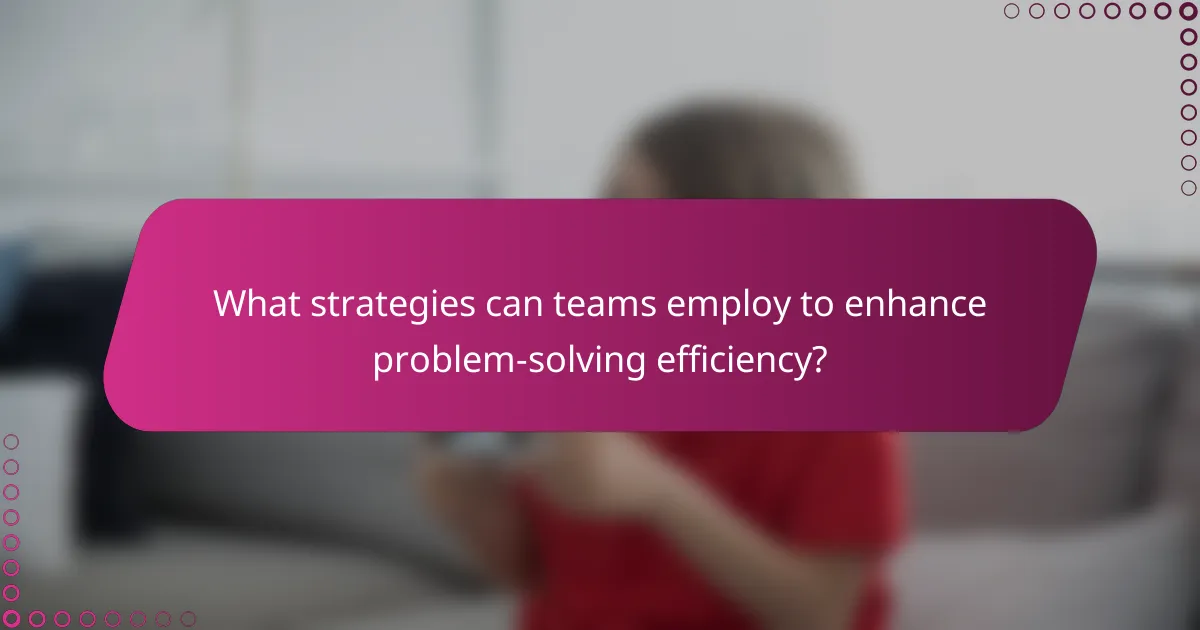
What strategies can teams employ to enhance problem-solving efficiency?
Teams can enhance problem-solving efficiency in collaborative puzzle adventure games by employing clear communication, defined roles, and strategic planning. Effective communication fosters idea sharing, while defined roles leverage individual strengths. Strategic planning enables teams to outline objectives and allocate resources efficiently. Engaging in regular reflection on team performance can further refine strategies.
How does brainstorming impact puzzle-solving outcomes?
Brainstorming enhances puzzle-solving outcomes by fostering creativity and collaboration among team members. It encourages diverse ideas and perspectives, leading to innovative solutions. Teams that engage in brainstorming often experience improved communication and a stronger sense of community, which can significantly boost their effectiveness in collaborative puzzle adventure games. This dynamic teamwork strategy not only enhances problem-solving but also strengthens group cohesion, making the gaming experience more enjoyable and engaging.
Which teamwork strategies are most effective in high-pressure situations?
Effective teamwork strategies in high-pressure situations include clear communication, role delegation, and trust-building. These strategies enhance collaboration and decision-making under stress.
Clear communication ensures all team members understand objectives and expectations. Role delegation allows individuals to focus on their strengths, improving efficiency. Trust-building fosters a supportive environment, encouraging risk-taking and innovation during challenges.
In collaborative puzzle adventure games, these strategies are crucial for navigating complex tasks and achieving common goals. Teams that implement these approaches tend to perform better and maintain engagement.
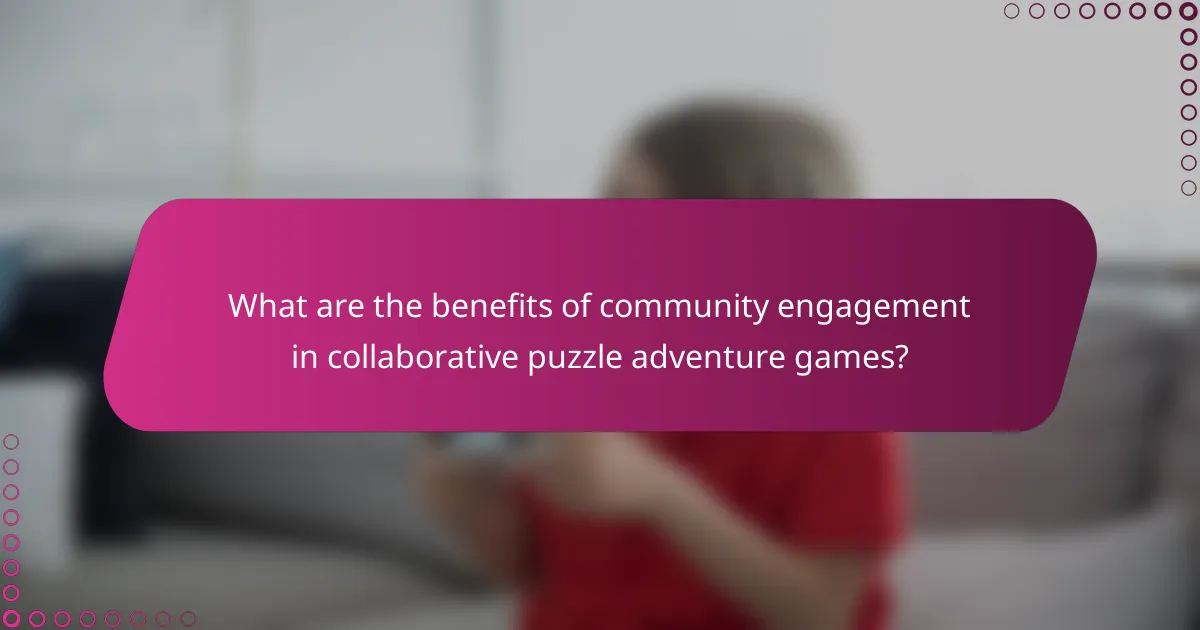
What are the benefits of community engagement in collaborative puzzle adventure games?
Community engagement in collaborative puzzle adventure games enhances player experience, fosters teamwork, and builds lasting relationships. Engaging with others promotes diverse problem-solving approaches, improving game outcomes. Players share strategies and insights, enriching the gameplay experience. This interaction cultivates a sense of belonging, encouraging ongoing participation and community growth. Additionally, community events and challenges strengthen connections, leading to increased player retention and satisfaction.
How do online forums and social media influence player collaboration?
Online forums and social media significantly enhance player collaboration in collaborative puzzle adventure games. These platforms foster communication, allowing players to share strategies, tips, and experiences.
Forums create dedicated spaces for players to discuss game mechanics and collaborate on challenges. Social media facilitates real-time interaction, enabling players to form teams and engage in events.
As a result, community engagement increases, leading to improved teamwork strategies. Players can exchange unique insights, enhancing overall gameplay and fostering a sense of belonging. This collaborative environment directly influences success in multiplayer dynamics.
What role do community events play in fostering teamwork?
Community events significantly enhance teamwork by promoting collaboration and communication among participants. These gatherings create opportunities for players to engage in collaborative puzzle adventure games, fostering a sense of unity. Participants develop teamwork strategies that improve their problem-solving skills and build trust. Additionally, community events encourage social interactions, which strengthen relationships and enhance group dynamics.
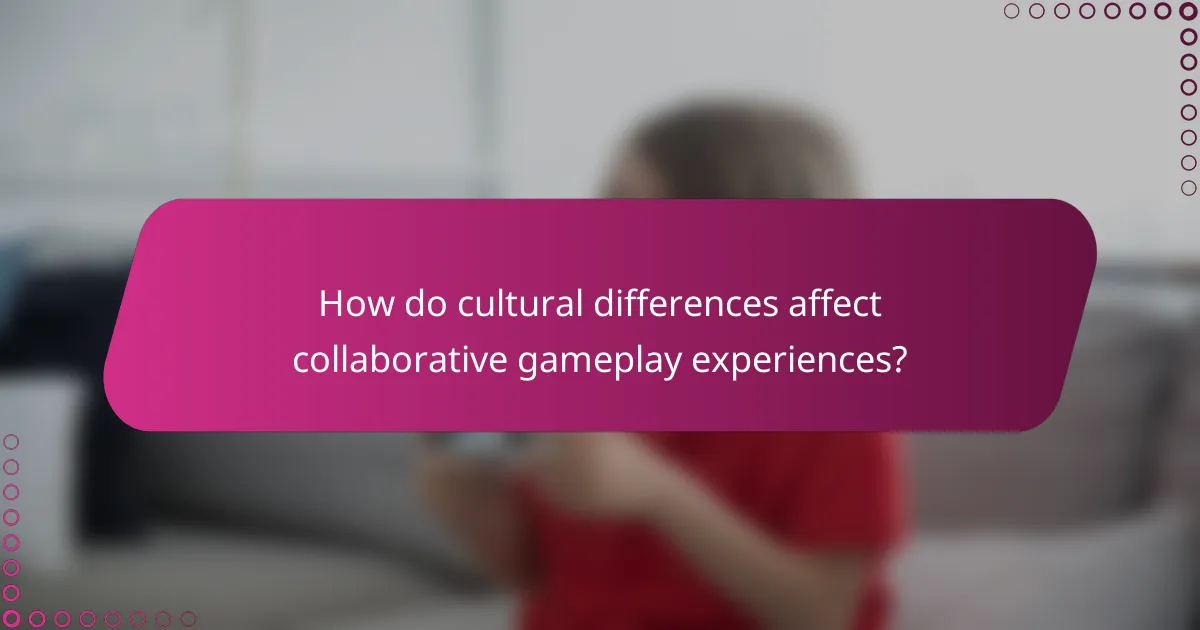
How do cultural differences affect collaborative gameplay experiences?
Cultural differences significantly influence collaborative gameplay experiences in puzzle adventure games. These variations shape communication styles, problem-solving approaches, and teamwork dynamics.
Players from diverse backgrounds may exhibit distinct preferences for collaboration. For instance, some cultures emphasize collective decision-making, while others prioritize individual contributions. These differences can lead to misunderstandings or conflicts during gameplay.
Effective teamwork strategies must account for these cultural nuances. Teams can enhance their collaborative experiences by fostering open communication, encouraging cultural awareness, and adapting to varied problem-solving methods.
Community engagement also varies across cultures. Some players may prefer competitive interactions, while others value cooperative gameplay. Understanding these preferences can enhance community-building efforts within multiplayer environments.
What variations exist in player communication styles across regions?
Player communication styles in collaborative puzzle adventure games vary significantly across regions due to cultural influences. For instance, players in collectivist cultures often emphasize teamwork and shared goals, while those in individualistic cultures may focus on personal achievement and strategy. Additionally, language barriers can affect communication methods, leading to the use of non-verbal cues or simplified language. Regional preferences for game mechanics also influence how players interact, with some regions favoring direct communication and others preferring indirect or nuanced dialogue. Understanding these variations enhances community engagement and teamwork strategies in multiplayer dynamics.
How do local gaming communities shape game development and player engagement?
Local gaming communities significantly influence game development and player engagement by fostering collaboration and shared experiences. These communities encourage developers to incorporate player feedback, leading to games that resonate with users.
Multiplayer dynamics in collaborative puzzle adventure games thrive on teamwork strategies, where players must communicate effectively to solve challenges. Community engagement enhances this experience, as players share strategies and form lasting relationships beyond the game.
Furthermore, local gaming events and meetups create opportunities for direct interaction between developers and players, promoting a cycle of continuous improvement and innovation. As a result, these communities not only shape game content but also enhance player loyalty and satisfaction.

What challenges do players face in collaborative puzzle adventure games?
Players face several challenges in collaborative puzzle adventure games, including communication barriers, differing skill levels, and varying play styles. Effective teamwork is often hindered by misinterpretations of clues or tasks. Additionally, time constraints can create pressure, leading to frustration among team members. Balancing individual contributions while ensuring collective progress remains a persistent challenge.
How can conflicts within teams impact gameplay?
Conflicts within teams can significantly hinder gameplay in collaborative puzzle adventure games. They disrupt communication, decrease morale, and can lead to poor decision-making. Effective teamwork is essential for solving complex puzzles, and conflicts can stall progress.
Additionally, unresolved tensions may fragment team dynamics, leading to players working in silos rather than collaboratively. This lack of synergy can result in missed opportunities for creative solutions and reduced overall enjoyment of the game.
To mitigate these impacts, teams should establish clear communication strategies and conflict resolution mechanisms. This fosters a positive environment where players feel valued and motivated to contribute.
What are the common pitfalls that hinder collaboration?
Common pitfalls that hinder collaboration include poor communication, lack of trust, unclear goals, and insufficient role clarity. These issues can lead to misunderstandings and reduced team effectiveness. Addressing these pitfalls is crucial for enhancing teamwork in collaborative puzzle adventure games.
Poor communication can result in team members not sharing critical information, while lack of trust may prevent open dialogue. Unclear goals lead to misalignment in efforts, and insufficient role clarity can cause overlaps or gaps in responsibilities. Recognizing and mitigating these challenges fosters a more cohesive team dynamic.
How can teams overcome communication barriers?
Teams can overcome communication barriers by fostering an environment of trust and openness. Implementing regular check-ins encourages dialogue and feedback among team members. Utilizing collaborative tools enhances real-time communication, allowing for seamless interaction. Establishing clear roles and responsibilities minimizes confusion and promotes accountability within the team. Engaging in team-building activities strengthens relationships and improves understanding of diverse communication styles.
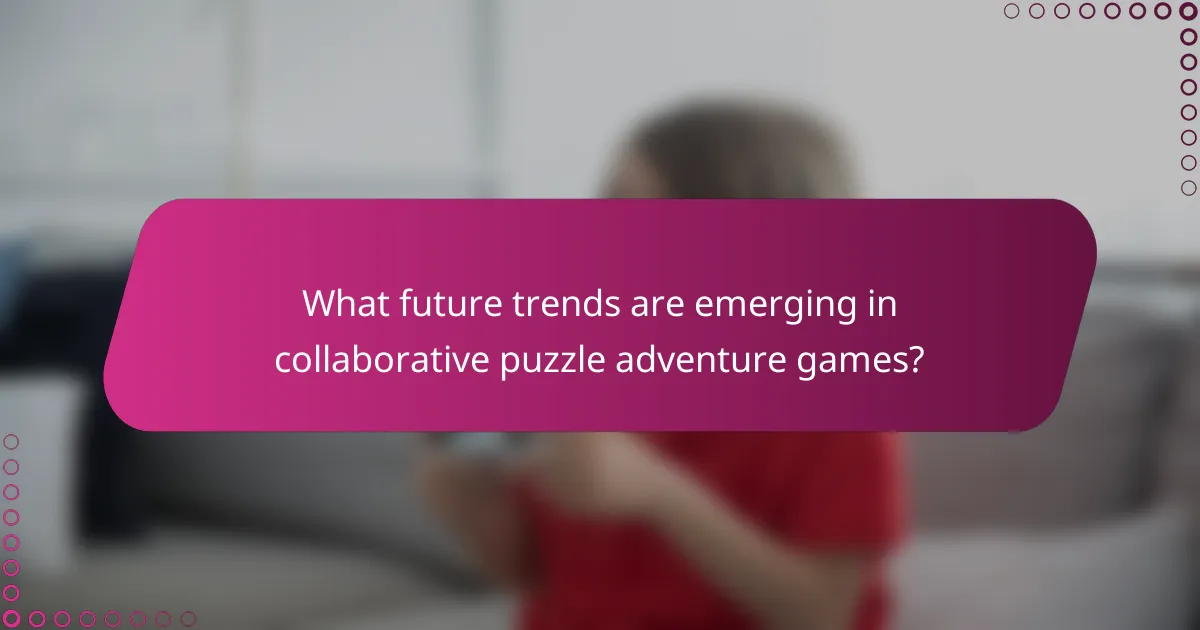
What future trends are emerging in collaborative puzzle adventure games?
Emerging trends in collaborative puzzle adventure games focus on enhanced multiplayer dynamics, innovative teamwork strategies, and deeper community engagement. As technology advances, cross-platform play becomes more prevalent, allowing diverse players to unite.
Increased use of artificial intelligence facilitates adaptive puzzles that respond to team behaviors, enhancing the challenge and engagement. Unique attributes, such as customizable avatars and environments, foster personal connections among players.
Community-driven content creation encourages players to design puzzles, promoting a sense of ownership and collaboration. Additionally, live events and seasonal updates keep the gaming experience fresh, maintaining player interest and involvement.
These trends indicate a shift towards more immersive and interactive gameplay, where teamwork and community play pivotal roles in enhancing the overall experience.
How is technology shaping multiplayer dynamics in these games?
Technology significantly enhances multiplayer dynamics in collaborative puzzle adventure games by facilitating communication, coordination, and engagement. Online platforms enable real-time interaction among players, fostering teamwork and strategic problem-solving. Advanced algorithms adapt challenges based on group performance, ensuring a tailored experience. Additionally, integrated community features allow players to share strategies and achievements, strengthening social bonds.
What innovations are enhancing community engagement?
Collaborative puzzle adventure games enhance community engagement through innovative multiplayer dynamics and teamwork strategies. These games foster communication, collaboration, and problem-solving among players, creating a sense of belonging. Enhanced features like real-time interaction and shared objectives deepen connections within the community. Additionally, in-game events and challenges encourage participation, driving engagement further.
Which upcoming titles are generating excitement in the genre?
Several upcoming titles in the collaborative puzzle adventure genre are generating excitement, including “The Last Campfire,” “We Were Here Forever,” and “Couch Co-Op.” These games emphasize teamwork, innovative puzzles, and community engagement, enhancing the multiplayer experience. Players can expect unique mechanics, immersive storytelling, and opportunities for strategic collaboration. Each title aims to foster social interaction and problem-solving among players, making the genre more appealing.
What best practices can teams adopt for successful collaborative gameplay?
Successful collaborative gameplay in puzzle adventure games involves clear communication, defined roles, and mutual support among team members. Establishing a strategy that leverages each player’s strengths enhances problem-solving efficiency. Regular check-ins maintain alignment on objectives, while fostering a positive atmosphere encourages creativity and resilience. Engaging with the community can provide additional insights and strategies, enriching the gameplay experience.
